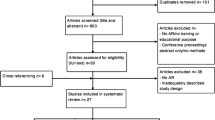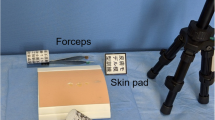Abstract
Background
Laparoscopic skills training has evolved over recent years. However, conveying a mentor’s directions using conventional methods, without realistic on-screen visual cues, can be difficult and confusing. To facilitate laparoscopic skill transference, an augmented reality telementoring (ART) platform was designed to overlay the instruments of a mentor onto the trainee’s laparoscopic monitor. The aim of this study was to compare the effectiveness of this new teaching modality to traditional methods in novices performing an intracorporeal suturing task.
Methods
Nineteen pre-medical and medical students were randomized into traditional mentoring (n = 9) and ART (n = 10) groups for a laparoscopic suturing and knot-tying task. Subjects received either traditional mentoring or ART for 1 h on the validated fundamentals of laparoscopic surgery intracorporeal suturing task. Tasks for suturing were recorded and scored for time and errors. Results were analyzed using means, standard deviation, power regression analysis, correlation coefficient, analysis of variance, and student’s t test.
Results
Using Wright’s cumulative average model (Y = aX b) the learning curve slope was significantly steeper, demonstrating faster skill acquisition, for the ART group (b = −0.567, r 2 = 0.92) than the control group (b = −0.453, r 2 = 0.74). At the end of 10 repetitions or 1 h of practice, the ART group was faster versus traditional (mean 167.4 vs. 242.4 s, p = 0.014). The ART group also had fewer fails (8) than the traditional group (13).
Conclusion
The ART Platform may be a more effective training technique in teaching laparoscopic skills to novices compared to traditional methods. ART conferred a shorter learning curve, which was more pronounced in the first 4 trials. ART reduced the number of failed attempts and resulted in faster suture times by the end of the training session. ART may be a more effective training tool in laparoscopic surgical training for complex tasks than traditional methods.




Similar content being viewed by others
References
Issenberg SB, Scalese RJ (2008) Simulation in health care education. Perspect Biol Med 51:31–46
Wanzel KR, Ward M, Reznick RK (2002) Teaching the surgical craft: from selection to certification. Curr Probl Surg 39:573–659
Botden SMBI, Jakimowicz JJ (2009) What is going on in augmented reality simulation in laparoscopic surgery? Surg Endosc 23:1693–1700
Botden SMBI, Buzink SN, Schijven MP, Jakimowicz JJ (2008) ProMIS augmented reality training of laparoscopic procedures face validity. Simul Healthc 3:97–102
Panait L, Hogle NJ, Fowler DL, Bell RL, Roberts KE, Duffy AJ (2011) Completion of a novel, virtual-reality-based, advanced laparoscopic curriculum improves advanced laparoscopic skills in senior residents. J Surg Educ 68:121–125
Panait L, Rafiq A, Tomulescu V, Boanca C, Popescu I, Carbonell A, Merrell RC (2006) Telementoring versus on-site mentoring in virtual reality-based surgical training. Surg Endosc 20:113–118
Larsen CR, Soerensen JL, Grantcharov TP, Dalsgaard T, Schouenborg L, Ottosen C, Schroeder TV, Ottesen BS (2009) Effect of virtual reality training on laparoscopic surgery: randomised controlled trial. BMJ 338:b1802
Larsen CR, Oestergaard J, Ottesen BS, Soerensen JL (2012) The efficacy of virtual reality simulation training in laparoscopy: a systematic review of randomized trials. Acta Obstet Gynecol Scand 91:1015–1028
Palter VN, Grantcharov TP (2012) Development and validation of a comprehensive curriculum to teach an advanced minimally invasive procedure: a randomized controlled trial. Ann Surg 256:25–32
Aggarwal R, Ward J, Balasundaram I, Sains P, Athanasiou T, Darzi A (2007) Proving the effectiveness of virtual reality simulation for training in laparoscopic surgery. Ann Surg 246:771–779
Schlachta CM, Mamazza J, Seshadri PA, Cadeddu M, Gregoire R, Poulin EC (2001) Defining a learning curve for laparoscopic colorectal resections. Dis Colon Rectum 44:217–222
Okrainec A, Ferri LE, Feldman LS, Fried GM (2011) Defining the learning curve in laparoscopic paraesophageal hernia repair: a CUSUM analysis. Surg Endosc 25:1083–1087
Costantino F, Mutter D, D’Agostino J, Dente M, Leroy J, Wu HS, Marescaux J (2012) Mentored trainees obtain comparable operative results to experts in complex laparoscopic colorectal surgery. Int J Colorectal Dis 27:65–69
Sebajang H, Trudeau P, Dougall A, Hegge S, McKinley C, Anvari M (2005) Telementoring: an important enabling tool for the community surgeon. Surg Innov 12:327–331
Sebajang H, Trudeau P, Dougall A, Hegge S, McKinley C, Anvari M (2006) The role of telementoring and telerobotic assistance in the provision of laparoscopic colorectal surgery in rural areas. Surg Endosc 20:1389–1393
Schlachta CM, Lefebvre KL, Sorsdahl AK, Jayaraman S (2010) Mentoring and telementoring leads to effective incorporation of laparoscopic colon surgery. Surg Endosc 24:841–844
Antoniou SA, Antoniou GA, Franzen J, Bollmann S, Koch OO, Pointner R, Granderath FA (2012) A comprehensive review of telementoring applications in laparoscopic general surgery. Surg Endosc 26:2111–2116
Botden SMBI, Berlage JTM, Schijven MP, Jakimowicz JJ (2008) Face validity study of the ProMIS augmented reality laparoscopic suturing simulator. Surg Technol Int 17:26–32
Botden SMBI, Hingh IHJT, Jakimowicz JJ (2008) Suturing training in augmented reality: gaining proficiency in suturing skills faster. Surg Endosc 23:2131–2137
LeBlanc F, Champagne BJ, Augestad KM, Neary PC, Senagore AJ, Ellis CN, Delaney CP (2010) A comparison of human cadaver and augmented reality simulator models for straight laparoscopic colorectal skills acquisition training. J Am Coll Surg 211:250–255
Nakamoto M, Ukimura O, Faber K, Gill IS (2012) Current progress on augmented reality visualization in endoscopic surgery. Curr Opin Urol 22:121–126
Nicolau S, Soler L, Mutter D, Marescaux J (2011) Augmented reality in laparoscopic surgical oncology. Surg Oncol 20:189–201
Veldkamp R, Kuhry E, Hop WCJ, Jeekel J, Kazemier G, Bonjer HJ, Haglind E, Påhlman L, Cuesta MA, Msika S, Morino M, Lacy AM (2005) Laparoscopic surgery versus open surgery for colon cancer: short-term outcomes of a randomised trial. Lancet Oncol 6:477–484
Salimath J, Jones M, Hunt D, Lane M (2007) Comparison of return of bowel function and length of stay in patients undergoing laparoscopic versus open colectomy. JSLS 11:72–75
Acknowledgments
Internal Research Grant from the Department of Surgery, University of Nevada School of Medicine
Disclosures
Drs. Russo and Tsuda, and Angelina Vera and Adnan Mohsin have no conflict of interest or financial ties to disclose.
Author information
Authors and Affiliations
Corresponding author
Rights and permissions
About this article
Cite this article
Vera, A.M., Russo, M., Mohsin, A. et al. Augmented reality telementoring (ART) platform: a randomized controlled trial to assess the efficacy of a new surgical education technology. Surg Endosc 28, 3467–3472 (2014). https://doi.org/10.1007/s00464-014-3625-4
Received:
Accepted:
Published:
Issue Date:
DOI: https://doi.org/10.1007/s00464-014-3625-4




